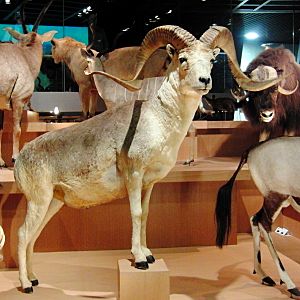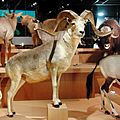Argali facts for kids
Quick facts for kids Argali |
|
|---|---|
 |
|
| Argali (Ovis ammon) | |
| Conservation status | |
| Scientific classification | |
| Kingdom: | |
| Phylum: | |
| Class: | |
| Order: | |
| Family: | |
| Subfamily: | |
| Genus: | |
| Species: |
O. ammon
|
| Binomial name | |
| Ovis ammon (Linnaeus, 1758)
|
|
The argali (Ovis ammon), also known as the mountain sheep, is a type of wild sheep. These amazing animals live in the high mountains of Central Asia. You can find them in places like the Himalayas, Tibet, and the Altai Mountains.
The argali is the biggest wild sheep in the world. It can stand as tall as 120 cm (about 4 feet) at the shoulder. It can also weigh as much as 140 kg (about 300 pounds). One type, the Pamir argali, is sometimes called the Marco Polo sheep. This is because the famous traveler Marco Polo first wrote about them. These sheep can be over 6 feet long! Sadly, argali are considered an endangered animal around the world.
Contents
What Does an Argali Look Like?
The argali is the largest kind of wild sheep. While the North American bighorn sheep can be quite heavy, the argali is usually much bigger. Argali stand about 85 to 135 cm (2.8 to 4.4 feet) tall at the shoulder. They measure 136 to 200 cm (4.5 to 6.6 feet) long from head to tail.
Female argali, called ewes, are much smaller than males. A ewe might weigh less than half of what a male weighs. Ewes can weigh from 43.2 to 100 kg (95 to 220 lb). Male argali, called rams, typically weigh from 97 to 328 kg (214 to 723 lb). The heaviest argali ever reported weighed 356 kg (785 lb)!
The Pamir argali, also known as the Marco Polo sheep, is the largest type on average. These rams often measure over 180 cm (5.9 feet) long without their tail. Argali have the shortest tails of any wild goat-antelope or sheep. Their tails are usually only 9.5 to 17 cm (3.7 to 6.7 in) long.
The color of an argali's coat can be different for each animal. It can range from a light yellow to a reddish-brown or even a dark grey-brown. Argali from the Himalayas are usually darker. Those from Russia are often paler. In summer, their coat might have a light "salt-and-pepper" pattern. Their back is darker than their sides, which get lighter in color. Their face, tail, and rear are yellowish-white.
Male argali have a whitish ruff of fur around their neck. They also have a crest of fur along their back. Rams are usually a bit darker in color than ewes. Males have two very large, corkscrew-shaped horns. Some of these horns can be 190 cm (6.2 feet) long in total. They can weigh up to 23 kg (51 lb)! Rams use their horns to compete with other males. Females also have horns, but they are much smaller. Their horns are usually less than 50 cm (20 in) long.
Where Do Argali Live?
Argali live in a wide area across Asia. Their range stretches from central Kazakhstan in the west to the Shanxi Province in China in the east. From north to south, they live from the Altai Mountains to the Himalayas.
These sheep are mountain animals. They can be found at very high elevations, from 300 to 5800 m (980 to 19,000 feet). In areas where they are protected, argali usually prefer gently sloping areas. These areas have soft, broken ground. However, ewes with their young often live in steeper places. These spots have canyons and jagged rocks.
In places where argali are hunted a lot, like Kazakhstan, they might hide in forested areas. In parts of China and Russia, argali compete with many farm animals for food. So, they often live in very steep, rocky areas there. Argali might look for mountain regions where the snow is not too deep in winter. They follow winds that blow snow off the ground. Male argali are usually found at higher elevations more often than females. They also stay at these higher places longer during winter.
What Do Argali Eat?
Adult argali eat a lot of food, about 16 to 19 kg (35 to 42 lb) every day. The plants they prefer to eat depend on how high up they live and the specific area. In very high mountains, they mostly eat grasses, sedges, and other small plants called forbs. In middle-elevation areas, they eat more bushes and certain types of grasses.
In the lowest areas and near deserts, grasses and sedges are again their main food. However, these are often different kinds of plants than those found at high elevations. In north-central Kazakhstan, argali eat sprouts, leaves, flowers, and fruits all year round. In other places, these foods are only a rare treat.
Argali need water to drink. This is usually not a problem for those living in high mountains. There, they often find melting snow and small streams. In drier places, argali might travel several kilometers to find water. When they can find it, argali also like to eat salty soil.
Images for kids
-
Stuffed specimen at the National Museum of Nature and Science, Tokyo.
See also
 In Spanish: Argalí para niños
In Spanish: Argalí para niños





